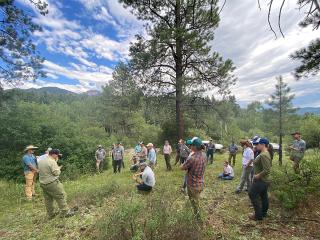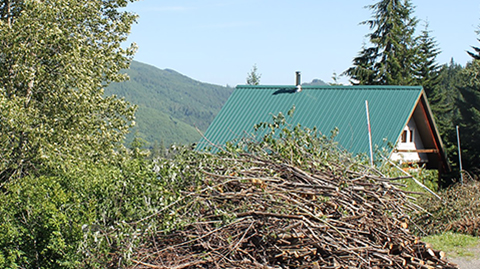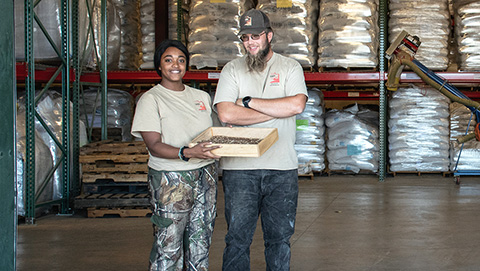
Across the arid Southwest, prolonged drought, increased fuel loading and past fire exclusion left many communities at risk for catastrophic wildfire.
"We've been living in extreme fire danger for far too long,” said Esmé Cadiente, Southwest Regional Director at the Forest Stewards Guild.
To reduce the likelihood of wildfires, pre-plan for post fire impacts, and develop a culture of shared responsibility, the Forest Service partnered with nearby communities and organizations to develop the (CFLRP), which is funded through the Infrastructure Investment and Jobs Act. The Forest Stewards Guild and Mountain Studies Institute are two of these key partners and work with the Forest Service to reach, educate and train community members across boundaries.
Bringing lands together
The project’s expansive footprint stretches from the headwaters of the Rio Grande and San Juan Rivers in Colorado to the Rio Chama Valley in New Mexico.
“This project has large implications for Southwest forests and the communities that rely upon them. With this influx of federal funding and support from on-the-ground stakeholders, we have an opportunity to work at a large enough scale to actually make a difference," said Gabe Kohler, program manager with the Forest Stewards Guild. “We need to coordinate with local partners and use the best available socioeconomic data to tailor our work to nearby communities, especially those that may be disproportionately vulnerable to wildfire, post-fire effects and climate change.”
The Rio Chama project provides a framework for all landowners to work together to mitigate the impacts of future forest disturbances like wildfire, insects and disease and climate change in the spirit of Shared Stewardship. This framework enables participants to focus upon shared values, local needs and landscape-scale forest and watershed treatments that cross jurisdictions and ownership boundaries.
Project participants seek to improve forest resilience through fuel treatments and to improve water quality, fish and wildlife habitat, and watershed function by restoring watershed and riparian areas. They also seek to create jobs and support local rural economies by using restoration by-products as fuelwood and construction materials for traditional buildings. By connecting with tribes and communities that share waterways and large tracts of land, the project team works to ensure consistent communication and collaboration.

Bringing people together
Vast projects require extensive resources, including partners to make the Rio Chama project goals a reality. For this, the Rio Chama project tapped into existing and extensive community engagement led by the Two Watersheds-Three Rivers-Two States Cohesive Strategy Partnership, also known as the 2-3-2 Partnership.
Through the 2-3-2 Partnership, the agency works closely with local watershed groups, private landowners, tribes and state and federal agencies to treat, manage and monitor landscapes across property boundaries on the Rio Chama CFLRP.
“Working together has really increased our capacity, our available tools, and has increased the opportunity for important stakeholders to have a voice,” said Andrea Jones who is the District Ranger and decision maker for the Conejos Peak Ranger District on the Rio Grande National Forest.
In 2023 and the decade ahead, the project partners will increase the pace and scale of restoration by using mechanical thinning and prescribed fire after thoughtful consideration of new prescribed fire guidelines. They also plan to employ less conventional methods, such as the “Mayordomo” Model that expands cooperative forestry benefits to vulnerable communities by employing local leñeros, or “skilled wood cutters,” to reduce hazardous fuels. Leñeros develop, implement and oversee small-scale stewardship projects to treat acres in and around their communities.
The partnership also includes the All-Hands-All-Lands Burn Team, a collaborative effort led by The Forest Stewards Guild to accelerate the return of fire to fire-adapted landscapes. The All-Hands All Lands Burn Team works to get ahead of prescribed fire backlogs on federal, state and tribal lands. As a stand-alone organization, the team also assists private landowners in using prescribed fire by providing insured and qualified burn bosses.
Providing vital resources
Another initiative included in the Rio Chama partnership is the National Forest Foundation’s (NFF) Wood for Life Program that supplies Indigenous communities with wood from forest restoration projects to heat homes. Project managers on the Santa Fe National Forest are currently implementing the Rock Creek Project, a joint effort between the Forest Service and NFF that will provide fuelwood for tribal communities as well as commercial timber for local mills. Land managers and partners are working to expand this program into other areas and forests within the Rio Chama CFLRP footprint over the next 10 years.
"The 2-3-2 Partnership has also opened doors for increased partnerships and cross-boundary momentum toward treatment of the landscape to help protect critical values such as clean water,” said Andrea Jones, Conejos Peak District Ranger on the Rio Grande National Forest.
This landscape provides most of the drinking water for Albuquerque and about half the drinking water for Santa Fe. It is also home to a rich cultural heritage and offers an abundance of natural resources used by dozens of communities, including many tribal and rural land grant communities.
Forest Service land managers and partners continue to work closely together to achieve their mutual goals, hoping that this all-lands approach will help improve watershed function and forest resilience in the face of future disturbances while also bolstering local economies and providing forest products to rural communities.





